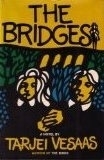What do you think?
Rate this book


183 pages, Hardcover
First published January 1, 1966
We lie like longing beside the footpaths.
We lie like fear above the hurrying highway where life goes to waste, where man hurries and hurries after emptiness. We are beside the houses in which they shut themselves away: the fortresses they have built in order to shut themselves in with their brief joys.
We are the thin, complaining wind that brushes past, searching for what cannot be present.
We are the wind behind the windāthat searches in defiance, in case something is to be found all the same.
We are where everyone is, and where no one was. We search night after night.
Ģż Ģż Ģż ĢżĢżWhispering: āCan you see it?ā�They agree not to tell anyone what theyāre foundāAud is the driving forced there: āI do know that weāre not going to involve more people just yet. Someone needs all the miserable help we can giveāāand return the next day to bury the baby only to be met by a girl ages with them, Valborg, who they learn was the childās mother and whom they end up arranging to meet up with every few days over the next couple of weeks to talk and try to support but none of them really get anywhere; their conversations are strained and no one really opens up. The only significant thing that happens is, with the introduction of another girl (and a sexually active one at that), the bond between Aud and Torvil is put to the test.
Ģż Ģż Ģż ĢżĢżTorvil nodded. He felt numbed.
Ģż Ģż Ģż ĢżĢżYes, he could see it, dimly in the half-light. Something that could only be a new-born, naked, lifeless child. It was lying under a few blackening twigs that had been awkwardly scraped together, ready to darken along with them.
Ģż Ģż Ģż ĢżĢżIt was a frightening sight when you had never imagined anything like it. The light fading around it made it seem even harder to bear.
Ģż Ģż Ģż ĢżĢżQuick glances at each other.
Ģż Ģż Ģż ĢżĢż āDid you see it?ā�
Ģż Ģż Ģż ĢżĢż āYes.ā�
[H]is work is characterized by simple, terse, and symbolic prose. His stories are often about simple rural people that undergo a severe psychological drama and who according to critics are described with immense psychological insight. Commonly dealing with themes such as death, guilt, angst, and other deep and intractable human emotions, the Norwegian natural landscape is a prevalent feature in his works.Itās a pretty decent description of how this novel plays out. Thereās more than a touch of the Pinteresque here too. Never has the open countryside felt so enclosed and foreboding; it doesnāt help that much of the action takes place around dusk. Thereās one scene, for example, where the three shelter under a tree:
Ģż Ģż Ģż ĢżĢżThey leant against the trunk. First stand and simply be aware of being together. But it was not possible. There was something about Valborg that prevented it; she was not open, but stiff and distant. On the other hand, the radiance over which she had no control was alive and active. Aud and Torvil were scared. They must make progressāb³Ü³Ł how was it going to turn out?Itās oppressive. The dialogue too, as with Pinter, is sometimes clumsy and unnatural by todayās standards. describes it ālike ā� two men sawing wood.ā�
Ģż Ģż Ģż ĢżĢżThe two of them stood trying to guess what was the matter with Valborg.
Ģż Ģż Ģż ĢżĢżThe tree was not so very thick after all: each of them had to face in a slightly different direction. [ā¦] Valborg in particular positioned herself so that she was looking at nothing besides the wet woods.
Paralleling the story, the form of the book as well moves out beyond narrative. Interpolated chapters are sunk, like vertical shafts, into the depths of life, into the blind, instinctual forces of nature, a Roethkeālike world of minute, creeping things and flowing waters and nightmare images of horror. These passages are often obscure and, one suspects, at times escape the writer's control; but they contain some of the most impressive language in the book.The quote of the cover from Literary Review calls the book a āmasterpieceā� but I didnāt feel like Iād read one when I was finished. It actually felt more like an experience rather than a straightforward story. I read The Birds a couple of years back which some regard as Vesaasās best workāalthough The Ice Palace may be better knownāb³Ü³Ł I had much the same problem with it as I had with The Bridges. In my review I wrote:
I have to be honest here. I can see why people love this book but I failed to connect with it... So I donāt know. This book ticks so many boxes, things that I look for in an ideal read, but for some reason failed to hold my interest.The thing about both books is I feel Iām missing something. Vesaas is hugely popular in his home country so there must be something there. I have to say I did find Catherine Wilsonās essay helpful so maybe Iāll give him one more go.